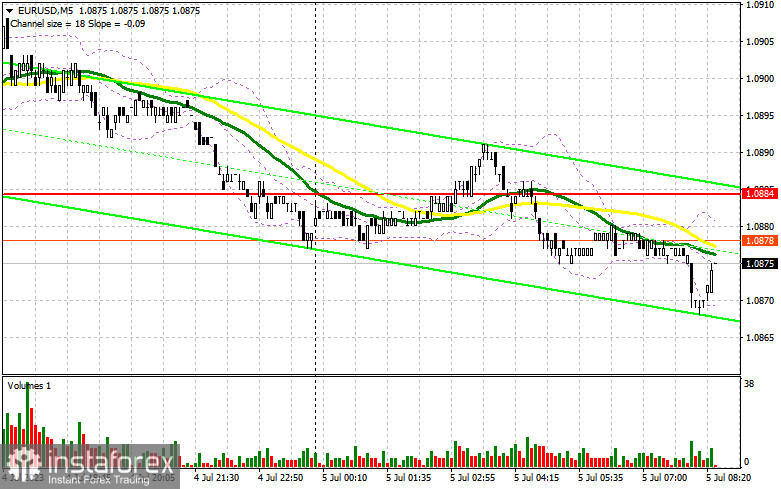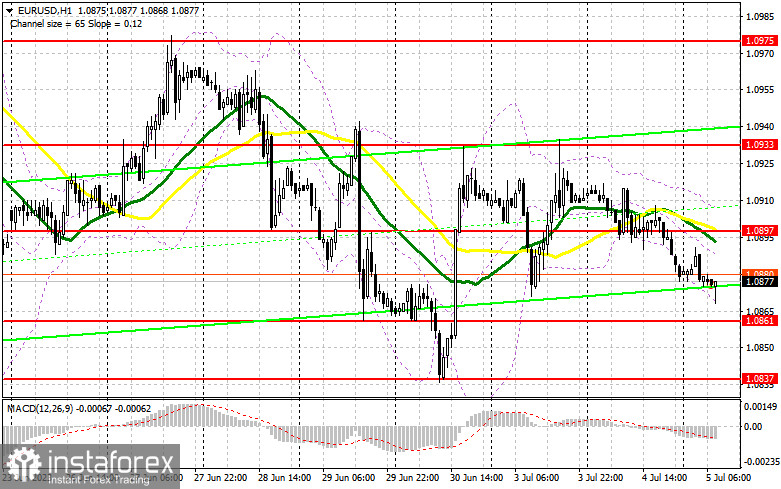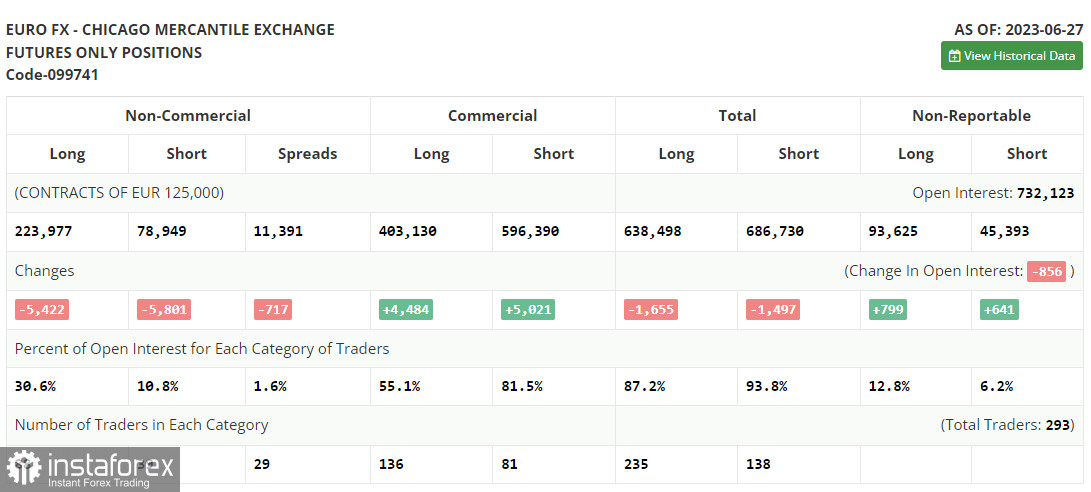Yesterday, there were no entry points. Now, let's look at the 5-minute chart and figure out what actually happened. In the first half of the day, it was not possible to reach the levels I highlighted due to low volatility. During the US session, a number of trading platforms were closed for the 4th of July holiday, so there were no suitable entry points.

For long positions on EUR/USD:
Investors are awaiting key Service PMI numbers in the euro area. These indicators will set the euro's direction in the first half of the day. The euro area services PMI and the composite PMI will be released. A slowdown will lead to another EUR/USD sell-off, extending yesterday's trend. Figures on producer prices in the eurozone are unlikely to have a direct impact on the pair, as investors are more interested in consumer inflation.
In case EUR/USD falls amid disappointing figures, I will only act on declines near the new support level of 1.0861 that was formed last week. A false breakout at this level will provide a buy signal, allowing a return to the key resistance at 1.089, which is in line with the bearish moving averages. A lot depends on that mark. A good eurozone services PMI will take the pair beyond this range. A breakout and a downward retest of this mark will strengthen demand for the euro and may bring it to 1.0933. The ultimate target remains the area of 1.0975 where I will take profit.
In the case of a decline in EUR/USD and the absence of buyers at 1.0861, bears may increase their presence. Therefore, only the formation of a false breakout around the next support at 1.0837 will provide a buy signal for the euro. I will open long positions immediately on a rebound from the low of 1.0807, keeping in mind an intraday upside correction of 30-35 pips.
For short positions on EUR/USD:
Big sellers will gradually return to the market, especially in the event of a poor PMI reading, which would signal the first signs of a downturn in the region's economy. Bears need to protect 1.0897. A false breakout is likely to give a sell signal that could push EUR/USD to the support level of 1.0861. If so, its breakout is sure to occur soon. Consolidation below this level as well as an upward retest could trigger a fall to 1.0837, last week's low, where sellers will already face strong levels. The ultimate target will be the low of 1.0807 where I will take profit. Testing this area will indicate the formation of a new bearish bias.

In the event of an upward movement of EUR/USD during the European session and the absence of bears at 1.0897, which is possible only if we receive good reports, the bulls will close the pair in the sideways channel. In such a case, I will postpone short positions until the pair hits the next resistance at 1.0933. Selling can also be done there but only after a failed consolidation. I will open short positions immediately on a rebound from the high of 1.0975, considering a downward correction of 30-35 pips.
COT report:
The COT report for June 27 showed a reduction in both long and short positions, leaving the market's balance practically unchanged. The GDP data released last week once again confirmed the resilience of the American economy even in the face of high interest rates, allowing the Federal Reserve to actively combat high inflation which is gradually returning to normal. In the near future, the minutes of the Fed's meeting will be released, and we will also learn about the state of the US labor market, which may strengthen the US dollar against the euro. In the current conditions, buying on pullbacks remains the optimal medium-term strategy. The COT report indicates that long positions of the non-commercial group of traders decreased by 5,422 to 223,977 while short positions fell by 5,801 to 78,949. At the end of the week, the overall non-commercial net position increased slightly to 145,028 compared to 144,025. The weekly closing price went up to 1.1006 from 1.0968.

Indicator signals:
Moving Averages
Trading is carried out below the 30 and 50 daily moving averages, which indicates the possibility of a downward correction.
Please note that the time period and levels of the moving averages are analyzed only for the H1 chart, which differs from the general definition of the classic daily moving averages on the D1 chart.
Bollinger Bands
If the pair falls, the lower band of the indicator at 1.0860 will act as support.
Description of indicators:
• A moving average of a 50-day period determines the current trend by smoothing volatility and noise; marked in yellow on the chart;
• A moving average of a 30-day period determines the current trend by smoothing volatility and noise; marked in green on the chart;
• MACD Indicator (Moving Average Convergence/Divergence) Fast EMA with a 12-day period; Slow EMA with a 26-day period. SMA with a 9-day period;
• Bollinger Bands: 20-day period;
• Non-commercial traders are speculators such as individual traders, hedge funds, and large institutions who use the futures market for speculative purposes and meet certain requirements;
• Long non-commercial positions represent the total number of long positions opened by non-commercial traders;
• Short non-commercial positions represent the total number of short positions opened by non-commercial traders;
• The non-commercial net position is the difference between short and long positions of non-commercial traders.
 English
English 
 Русский
Русский Bahasa Indonesia
Bahasa Indonesia Bahasa Malay
Bahasa Malay ไทย
ไทย Español
Español Deutsch
Deutsch Български
Български Français
Français Tiếng Việt
Tiếng Việt 中文
中文 বাংলা
বাংলা हिन्दी
हिन्दी Čeština
Čeština Українська
Українська Română
Română

